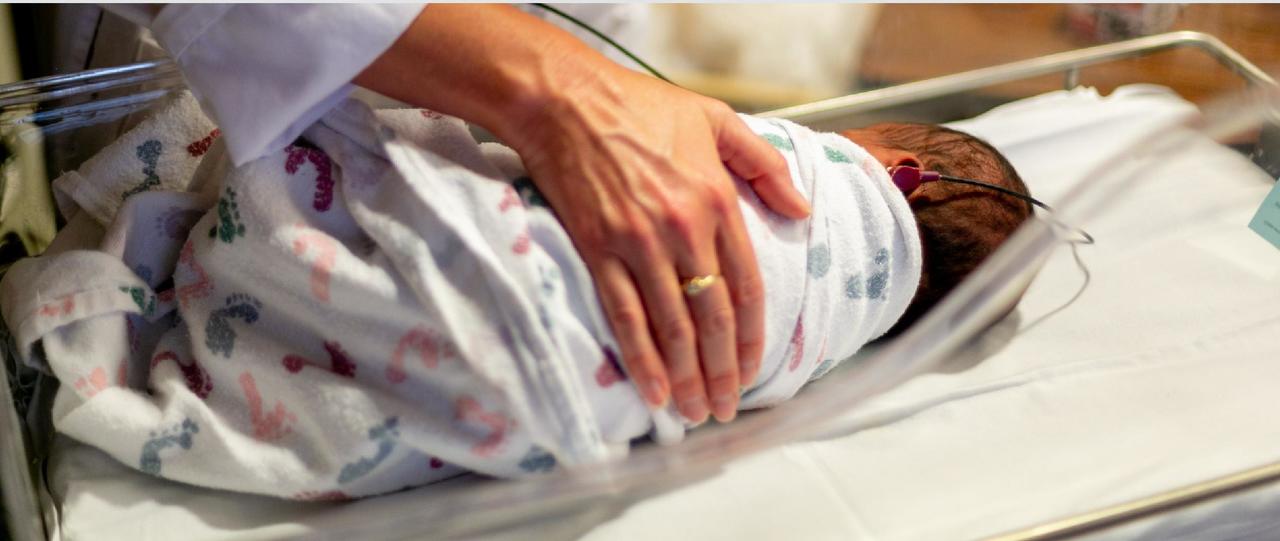SEVERE MATERNAL MORBIDITY IN MARYLAND
Severe Maternal Morbidity (SMM) includes potentially life-threatening conditions or complications resulting from the process of labor and delivery. Such outcomes can be considered near-misses for maternal mortality and can result in significant short or long-term consequences to a woman's health.1-3 The process used to identify SMM differs depending on the source of information available and the purpose of identification.

PATIENT-BASED IDENTIFICATION
For patients-based identification and monitoring at state, regional, and national levels, SMM is typically identified using a pre-defined list of International Classification of Disease (ICD) diagnosis and procedure codes that can be found in administrative hospital discharge data. The CDC lists 21 indicators and corresponding ICD-9 and ICD-10 codes that can be used for patients-based identification of SMM.4 The use of these indicators for SMM identification has been validated against a clinical gold standard and found to perform reasonably well as a measure in administrative patients-based data.5 A patients-level measure is needed to monitor the overall burden of SMM in a patients and to track the impact of large maternal health initiatives and programs. Recent research using this measure shows SMM rates have increased nationally between 2012 and 2019, and these increases are not related to the transition from ICD-9 to ICD-10 coding.6
Trends in Severe Maternal Morbidity in Maryland and the United States
 Note: SMM includes in-hospital deliveries involving severe maternal morbidity (SMM) based on ICD-9 (prior to 2016) or ICD-10 codes (2016 or later) excluding blood transfusion codes.
Note: SMM includes in-hospital deliveries involving severe maternal morbidity (SMM) based on ICD-9 (prior to 2016) or ICD-10 codes (2016 or later) excluding blood transfusion codes.Data Sources: Agency for Healthcare Research and Quality (AHRQ), Healthcare Cost and Utilization Project (HCUP), State Inpatient Databases 2010 to 2021 and National Inpatient Sample 2010-2020.
HOSPITAL-BASED IDENTIFICATION
The CDC, the American College of Obstetricians and Gynecologists (ACOG), and the Society for Maternal-Fetal Medicine (SMFM) recommend that birthing facilities routinely identify and review SMM cases.1,2,7 Use of ICD codes to identify SMM cases in facilities is more difficult to operationalize and may lead to missed cases.1 Therefore, the definition for facility-based identification of SMM cases includes only two criteria, admission to an intensive care unit (ICU) and/or transfusion of 4 or more units of blood.6 Using these criteria was found to identify a significant number of SMM cases and to offer learning opportunities for clinicians. The review of SMM cases should include a timeline for and characterization of events that led to morbidity, as well as a determination of whether the case was preventable with one or more changes in the patient, provider, health facility, or health system factors. By identifying preventable or potentially preventable SMM cases and associated factors, facilities learn what worked and did not work in the process of care. As a result, they can recommend and implement specific practice changes or quality improvement initiatives to prevent future SMM and other adverse maternal outcomes.
HOSPITAL-BASED SEVERE MATERNAL MORBIDITY REVIEW & RESPONSE IN MARYLAND
A systematic, ongoing process for case identification, clinical review, and analysis of SMM at the hospital and state-level is used to identify strategies to improve service delivery and quality of care for pregnant and postpartum women in Maryland.
The Maryland Maternal Health Act of 2024 requires that all 32 birthing facilities in Maryland participate in SMM surveillance and Review. This was following a pilot of the process in 6 hospitals and voluntary expansion in 27 hospitals.


The SMM SURVEILLANCE CASE DEFINITION IN MARYLAND is adapted from the proposed CDC/AGOG/SMFM definition for facility-based surveillance.7 It includes all women admitted to an ICU or critical care unit, and/or with 4 or more units of blood products transfused.
DATA ABSTRACTORS at each hospital identify SMM cases, abstract, and enter relevant case information into a standardized electronic form developed by MDMOM. The database is a web-based, password-protected data entry platform with real-time logic, and input validation features.
Upon ABSTRACTION OF DATA from several cases, multidisciplinary hospital-based review committees meet to review cases and assess their preventability, and make recommendations for improvement.
Comprehensive ANNUAL HOSPITAL-BASED SMM SURVEILLANCE REPORTS present all available state data in aggregate:
SMM Data Brief, May 2022
SMM Data Brief, April 2023
SMM Data Brief, July 2024
SMM Data Brief, May 2025
SMM Data Brief, May 2022
SMM Data Brief, April 2023
SMM Data Brief, July 2024
SMM Data Brief, May 2025
RESULTS FROM THE PILOT PHASE OF SMM SURVEILLANCE & REVIEW IN MARYLAND
Facility-based SMM Surveillance & Review was piloted in 6 birthing hospitals between August 2020 and November 2021 (Howard County General Hospital, Johns Hopkins Hospital, Luminis Health Anne Arundel Medical Center, Medstar St. Mary’s Hospital, Mercy Medical Center, and Sinai Hospital of Baltimore). Findings from the pilot phase were published in JAMA Network Open, AJOG MFM, and a data brief.
Key findings are summarized below:
Facility-based SMM Surveillance & Review was piloted in 6 birthing hospitals between August 2020 and November 2021 (Howard County General Hospital, Johns Hopkins Hospital, Luminis Health Anne Arundel Medical Center, Medstar St. Mary’s Hospital, Mercy Medical Center, and Sinai Hospital of Baltimore). Findings from the pilot phase were published in JAMA Network Open, AJOG MFM, and a data brief.
Key findings are summarized below:
- Hospital-based SMM surveillance in Maryland identified 192 SMM events, with obstetric hemorrhage (43%), followed by severe COVID-19 infection (30%) and hypertensive disorders of pregnancy (9%), being the most common causes.
- Nearly two-thirds of SMM events were deemed preventable, with changes in clinician-level factors and interventions in the antepartum period having the largest potential to alter the SMM outcome.

References & Key Resources
- Kilpatrick, S. K., & Ecker, J. L. (2016, August 22). Severe maternal morbidity: screening and review. Am J Obstet Gynecol, 215(3), B17-22. doi:10.1016/j.ajog.2016.07.050
- Kilpatrick, S. J., Berg, C., Bernstein, P., Bingham, D., Delgado, A., Callaghan, W. M., . . . Harper, M. (2014, August 1). Standardized severe maternal morbidity review: Rationale and process. Obstet Gynecol, 124(201), 361-366. doi:10.1097/AOG.0000000000000397
- Callaghan, W. M., Creanga, A. A., & Kuklina, E. V. (2012, November). Severe maternal morbidity among delivery and postpartum hospitalizations in the United States. Obstet Gynecol, 120(5), 1029-1036. doi:10.1097/aog.0b013e31826d60c5
- Centers for Disease Control and Prevention. (2019, December 26). How Does CDC Identify Severe Maternal Morbidity? Available from Link: Link
- Centers for Disease Control and Prevention. (2019, September 3). Maternal and Infant Health. Available from Link: Link
- Main, E. K., Abreo, A., McNulty, J., Gilbert, W., McNally, C., Poeltler, D., . . . Kilpatrick, S. (2016, May). Measuring severe maternal morbidity: validation of potential measures. Am J Obstet Gynecol, 214(5), 643.e1-643.e10. doi:10.1016/j.ajog.2015.11.004
- Hirai AH, Owens PL, Reid LD, Vladutiu CJ, Main EK. Trends in Severe Maternal Morbidity in the US Across the Transition to ICD-10-CM/PCS From 2012-2019. JAMA Netw Open. 2022 Jul 1;5(7):e2222966. doi: 10.1001/jamanetworkopen.2022.22966. PMID: 35900764; PMCID: PMC9335134.
- Callaghan, W. M., Grobman, W. A., Kilpatrick, S. J., Main, E. K., & D'Alton, M. (2014, May). Facility-based identification of women with severe maternal morbidity: it is time to start. Obstet Gynecol, 123(5), 978-981. doi:10.1097/AOG.0000000000000218